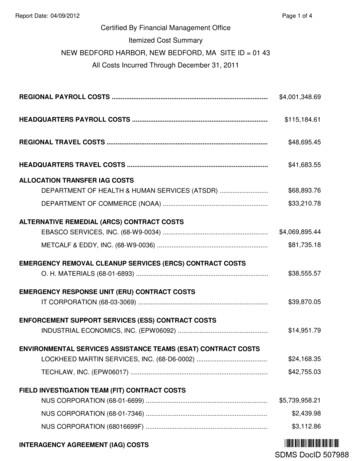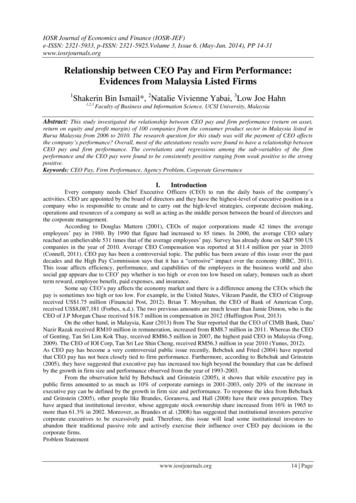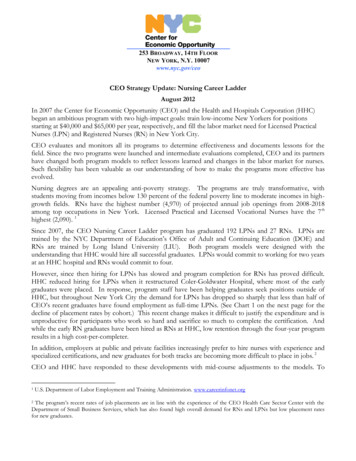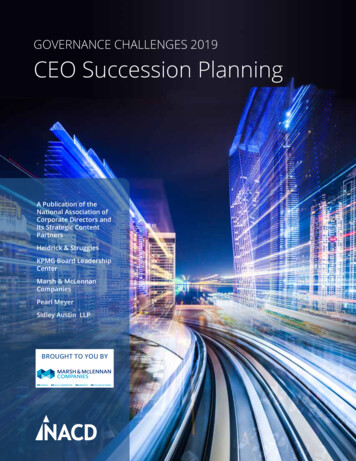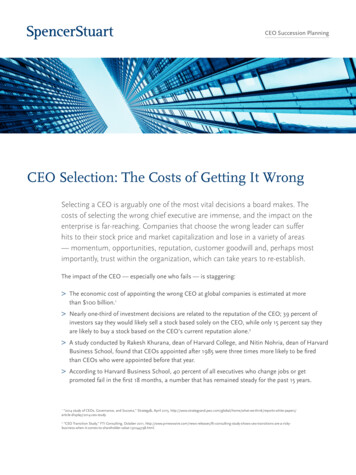
Transcription
CEO Succession PlanningCEO Selection: The Costs of Getting It WrongSelecting a CEO is arguably one of the most vital decisions a board makes. Thecosts of selecting the wrong chief executive are immense, and the impact on theenterprise is far-reaching. Companies that choose the wrong leader can sufferhits to their stock price and market capitalization and lose in a variety of areas— momentum, opportunities, reputation, customer goodwill and, perhaps mostimportantly, trust within the organization, which can take years to re-establish.The impact of the CEO — especially one who fails — is staggering: The economic cost of appointing the wrong CEO at global companies is estimated at morethan 100 billion.1 Nearly one-third of investment decisions are related to the reputation of the CEO; 39 percent ofinvestors say they would likely sell a stock based solely on the CEO, while only 15 percent say theyare likely to buy a stock based on the CEO’s current reputation alone.2 A study conducted by Rakesh Khurana, dean of Harvard College, and Nitin Nohria, dean of HarvardBusiness School, found that CEOs appointed after 1985 were three times more likely to be firedthan CEOs who were appointed before that year. According to Harvard Business School, 40 percent of all executives who change jobs or getpromoted fail in the first 18 months, a number that has remained steady for the past 15 years.1“2014 study of CEOs, Governance, and Success,” Strategy&, April 2015, eo-study.2“CEO Transition Study,” FTI Consulting, October 2011, ml.
ceo selection: the costs of getting it wrongWhy is CEO succession and selection so hard to get right? Many boards stillcling to a CEO selection process that sets organizations up for failure.Unfortunately, cautionary tales abound. Juan Trippe,viewed by many as the greatest airline CEO in history,led Pan Am through tremendous growth, establishingit as a best-in-class airline. In 1980, William Seawellsucceeded him, subsequently bought National Airlinesand took on significant debt to purchase a fleet of 747s— debt that would force the airline to declare bankruptcy in 1991. Kodak was once an industry leader withpeak revenues of 16 billion in 1996.3 However, a seriesof CEOs failed to help the company adapt to digitaldisruption and, ultimately, ushered it into obsolescence. Under its former CEO, Tesco lost more than 6 billion and cut thousands of jobs.4 The grocer’sexpansion into the U.S. failed and the company overstated its profits, sparking a fraud investigation andreputational damage. The failed merger of AOL andTime Warner — which some attributed to lack of duediligence and leadership around aligning the twocompanies’ distinct organizational cultures — wasa costly one: The company posted a nearly 99 billionloss two years after the merger was announced, and thetotal value of AOL Time Warner stock dropped from 226 billion to approximately 20 billion.5 The failureslisted in these few examples alone cost hundreds ofbillions of dollars.Despite understanding the high stakes of these decisionsand witnessing high-profile failures, boards have notmade wholesale improvement in CEO selection. Why isCEO succession and selection so hard to get right? Manyboards still cling to a CEO selection process that setsorganizations up for failure.3“The last Kodak moment?” The Economist, January 14, 2012, http://www.economist.com/node/21542796.4“Tesco results: the five reasons behind Tesco’s historic 6.4 billion loss,” The Independent,April 22, 2015, -64-billion-loss-10194620.html5“15 years later, lessons from failed AOL-Time Warner merger,” Fortune, January 10, here the process breaks downThe stakes of CEO selection require a process withcommensurate rigor. However, boards can overlookimportant components of the process, especially ifdirectors have never had to address succession previously. Here are some of the most common missteps:1The right people are not involvedin the selection.While the expertise of a previous CEO on the committeeis valuable, some boards become too reliant on thisperspective. Most airline passengers would not becomfortable on a flight where the pilot has never flownbefore. Similarly, the process runs more smoothly whenat least one member of the CEO selection committeepreviously chaired one. However, this experience is raregiven the episodic nature of CEO selection. Boardsshould prioritize CEO succession expertise when recruiting new members, even if there is no imminent transition.For the right balance of efficiency and diversity of perspectives, the optimal size of the committee is three to fourdirectors, typically including the lead director or non-executive chair. Audit committee chairs should not beassigned to the selection team, as the time commitmentis too great in the face of their existing responsibilities.Some organizations have found it helpful for the currentCEO to act in an “of counsel” capacity. However, depending on the level of emotion in the situation, the CEO’sinvolvement may do more harm than good. Even whenthe CEO has proactively made the decision to leave, itcan still be challenging for the executive to hand over thehelm. For example, once one chief executive’s retirementdate approached and his departure was no longer adistant prospect, he waffled on his original decision todepart. Additionally, board members with aspirations forthe CEO role can quickly undermine the integrity of theprocess and should recuse themselves well in advance ofthe formation of the selection committee.spencer stuart
2 43The board may not be equipped to evaluateCEO candidates.There is lack of alignment on how the processshould work.On average, boards tend to be extremely effective atunderstanding industry dynamics and financial andstrategic planning. However, it is far more challengingto accurately assess a potential CEO successor’sintegrity, fit with the organizational culture, ability toinspire and energize the enterprise, and capacity todevelop other leaders. Thus, many committees can fallinto the trap of overlooking or discounting what theycannot tangibly measure. Drawing on experts witha history of CEO and executive assessment can helpprovide a fuller picture of the candidate’s potential,as well as strengths and areas for development.A lack of agreement on the overall succession plancan undermine the selection process — and thesuccessor’s future success. A recent survey conductedby PwC revealed that nearly half of directors weredivided on their companies’ succession plans. Lackof alignment on the process may also indicate differingperceptions of the strategy and how to execute it,which can quickly derail a new CEO. Without unifiedboard support, the successor can quickly fall into thetrap of navigating conflicting mandates rather thandelivering on the organization’s strategic goals.The CEO specification does not align with theorganization’s strategic goals.At times, the articulated strategy is too rooted in thepresent and can include status quo assumptions, ratherthan reflecting a view of where the company needs tobe in five to 10 years. If the specification is built uponan outdated strategy, the successor could be set up forfailure. For example, if the strategic plan is to shift fromstable growth to more innovation, it may be necessaryto bring on a proven change agent versus a steadyhand. The criteria for the new CEO should be tied to thestrategic, organizational and operational levers that thenext CEO will need to employ.The length of the selection process also impacts the CEOspecification. The process can easily take more than twoyears, during which the market can change dramatically.However, many committees can be reluctant to pausethe process to reassess whether the expectations are stillrelevant out of fear of perceived failure.A best-in-class processWhile many factors contribute to selecting the wrongCEO, a strong succession framework significantlyincreases the odds of a long-term successful outcome.Taking the following steps can help organizations createa more surefire process.Opt for a committee that provides options.Ensure the committee provides a slate of choices to theboard — two to three candidates — after a transparent,inclusive process. Some committees tend to be moreinsular and hold more power in making the final decision; rather than presenting a few finalists, selectioncommittees present a single candidate for the board tovalidate. Although the process is often shorter when thecommittee presents a single candidate for recommendation, a more time-consuming, consensus-drivenapproach often yields better long-term results.It is worth noting that in many situations, the humanresources (HR) function may not be deeply involved inCEO succession. In these cases, it may be time fororganizations to revisit this approach, especially if theHR leader brings previous expertise that can contributeto the process.3
ceo selection: the costs of getting it wrongDevelop a forward-looking CEO specification.To go beyond generalities, the board should identify thevery specific effect it wants the next CEO to have on thebusiness and define the skills that it will take to accomplish that. The board of a company delivering solid butunremarkable returns, for example, may want the nextCEO to refocus on core businesses in untapped areasand lean toward a strong operator with a track recordof success in new market development. For a poorlyperforming company where strategy is the primaryThink creatively about candidates.contributor to lackluster returns, the board will haveWhen identifying candidates, be prepared to challengeto consider whether to tap a turnaround specialisttraditional assumptions. For example, the CEO’s directfrom outside the company. Even a company that hasreports may not be the bestdelivered consistently highcandidates going forward ifreturns versus industry peersthe organization needs toWhen identifying candidates, bemust evaluate how it willchange direction. Thecontinue to outperform, butprepared to challenge traditionalcommittee will have to reflectalso find ways to innovate,assumptions. For example, thecarefully on the range anddrive distinctiveness anddepth of the company’s likelyavoid the complacency thatCEO’s direct reports may not beinternal succession candican come with success. Whilethebestcandidatesgoingforwarddates — and considerexpectations for the CEOiftheorganizationneedstowhether changes in strategy,must be appropriately highthe nature of competition oraltitude, no more than five tochange direction.customer behavior suggestsix competencies should bethe need to look at a widerincluded — beyond that, thegroup of candidates both inside and outside theassessment of prospective candidates can become toocompany. In addition, if there are internal prospects todetailed and detract from the critical requirements.be considered, it can be helpful to assign a board director to help them navigate the process while continuingto contribute at the highest levels in their current roles.It can be beneficial for the board to work with a searchfirm that can develop a long list of prospects based onprevious roles, industry experience and preliminaryreference checks. It’s important to note that candidates should not advance in the selection processuntil preliminary referencing is conducted. Once theslate is narrowed to four to six candidates, they shouldbe assessed by the search committee and searchconsultant in order, resulting in the selection of twoto three finalists.4spencer stuart
Do not underestimate cultural fit.Boards will want to consider whether the culture of thecompany needs to shift or change, and how alignedindividual candidate profiles are with the desiredcompany culture.Prior to having the candidates evaluated by expertsin executive assessment and organizational culturealignment, the committee members (as a group orindividually) should spend additional time with thecandidates in different settings in order to begin togauge their cultural fit. Executives who are hired solelyfor their technical skills can fail if they do not align withthe culture.Understand the full picture.A rigorous review of an individual’s capabilities, including the observations of others who can validate theirperformance in current and past roles, can revealwhether candidates have the relevant experience aswell as potential areas for development. Gaps mayinclude a lack of specific knowledge or “hard skills,”such as experience with regulators or financiers, or adeficiency in certain “soft skills,” e.g., the ability to navigate complex interactions or to influence and motivateothers. Gaining insight into external talent — throughresearch, informal or formal introductions, or an executive search — can provide additional benchmarks whenassessing the readiness of potential successors.It is not enough to look at past accomplishments;boards should strive to gain an understanding ofcandidates’ analytical capabilities, social intelligenceand self-awareness — all skills that speak to an individual’s Executive Intelligence and ability to succeed inmore complex and demanding contexts. Years of dataand experience have demonstrated the predictive powerof these traits on executive performance — and theirlink to the performance of the business. Although someorganizations evaluate candidates based on personalitytesting, there is no clear correlation between personalityand performance.key steps for theselection committee inthe interview processüüMeet with the two finalist candidates andhave the chair lead the meeting to maximize efficiency. Each candidate shouldreceive 30 minutes to present his or herexperience and plans for the organization, followed by 45 to 60 minutes ofQ&A. The search consultant should bepresent only as an observer.üüProvide an interview guide to the boardoutlining the critical competencies fromthe position specification as well as thekey organizational culture attributesand ask each member to rate the candidates in these areas. The primary purpose of this exercise is to eliminatesubjectivity and focus on concrete skillsand performance.üüAgree on a single candidate.üüConduct formal references. The committee agrees on the list of questions, whichfocus on areas of concern.üüNote that references provided by thecandidate should not be weighed asheavily as others: A search firm can seekfeedback from former superiors, peersand subordinates. Ideally, these references should be done in person and members of the search committee should bepresent so that critical non-verbal communication is not lost.5
ceo selection: the costs of getting it wrongAt this point in the process, the committee can nowcompile and share the following multifaceted information with the entire board: the results from a capabilities-based interview,reflecting past performance; the results from a rigorous assessment of potentialand aptitude, predicting future performance; the results from preliminary reference checks and360-degree conversations about the candidate’sleadership style and its impact on the business,providing a current baseline; and cultural assessments, highlighting the differencebetween the CEO prospect and the current cultureof the enterprise, as well as the individual leader’sinterpersonal style.Set up the new CEO for success.Ideally, a 120-day plan is developed between theincoming CEO and the chairman. Once the new CEOis on the job, 360-reviews should be conducted on aperiodic basis in order to ensure early and frequentfeedback. Onboarding efforts are crucial and theprocess should be tailored for the role, developmentalneeds and the situation. Based on an assessment ofthe executive’s capabilities and areas for developmentduring the interview process, organizations can adjustonboarding to address specific areas. If the new CEOcomes from outside the organization, it can be beneficial to help new leaders understand the intangibles— who the decision-makers are, how decisions aremade and cultural nuances that may not be immediately obvious. It can also be valuable for HR to discussemployee engagement survey results to shed light onwhat is important to individuals throughout the organization, not just at the senior levels, especially whenchange usually must take place on the front lines. Clear,agreed-upon expectations for performance should alsobe covered in the onboarding process — a lack thereofcan quickly derail even the smartest leaders.6spencer stuart
ConclusionWith the high cost of failure — and the significantfinancial, reputational and talent impact of the rightdecision — boards need to reassess their CEO succession processes and ensure that they are supportingtheir strategic goals. There is no more important rolefor board members than selecting the organization’snext leader. In addition to the potential damage to theorganization, a poor decision in successor can alsojeopardize a director’s standing. Our experience hasshown that processes that have the best outcomesare those in which the right people are brought to thetable, the specification is designed with the future strategy in mind and candidates are assessed holistically.While there can be immense pressure to make a decision quickly, the board must resist that urge and takethe time necessary to make a fully informed decision.In addition, it’s important to remember that successionis rarely a neat process and the committee and chairneed to have realistic expectations. Those who do notinvest in developing strong selection processes well inadvance of CEO succession risk paying heavily later.about the authorJeff Hauswirth is a member of Spencer Stuart’s globalCEO and Board practices and has more than 20 yearsof executive and board search experience acrossdiverse industries. Jeff brings an extensive track recordof helping organizations worldwide systematicallyattract, select and secure CEOs who are able to havea lasting impact on the performance of the business.7
stonBrusselsBuenos enevaHong KongHoustonIstanbulJohannesburgLimaLondonLos AngelesMadridMelbourneMexico CityMiamiMilanAbout Spencer StuartAt Spencer Stuart,we know Stuarthow much leadership matters. We are trusted by organizationsAboutSpenceraround the world to help them make the senior-level leadership decisions that have a lastingAt Spencer Stuart, we know how much leadership matters. We are trusted by organizationsimpact on their enterprises. Through our executive search, board and leadership advisoryaround the world to help them make the senior-level leadership decisions that have a lastingservices, we help build and enhance high-performing teams for select clients ranging fromimpact on their enterprises. Through our executive search, board and leadership advisorymajor multinationals to emerging companies to nonprofit institutions.services, we help build and enhance high-performing teams for select clients ranging frommajor multinationalsto emergingto knowledge,nonprofit institutions.Privatelyheld since 1956,we focuscompanieson deliveringinsight and results through theMinneapolis/St. PaulMontrealMoscowMumbaiMunichNew DelhiNew YorkOrange CountyParisPhiladelphiacollaborative efforts of a team of experts — now spanning 56 offices, 30 countries and morePrivately held since 1956, we focus on delivering knowledge, insight and results through thethan 50 practice specialties. Boards and leaders consistently turn to Spencer Stuart to helpcollaborative efforts of a team of experts — now spanning 56 offices, 30 countries and moreaddress their evolving leadership needs in areas such as senior-level executive search, boardthan 50 practice specialties. Boards and leaders consistently turn to Spencer Stuart to helprecruitment, board effectiveness, succession planning, in-depth senior managementaddress their evolving leadership needs in areas such as senior-level executive search, boardassessment and many other facets of organizational effectiveness.recruitment, board effectiveness, succession planning, in-depth senior managementassessmentand manyonotherfacetsStuart,of organizationalFormore informationSpencerplease visit effectiveness.www.spencerstuart.com.PragueFor more information on Spencer Stuart, please visit www.spencerstuart.com.SingaporeRomeSan FranciscoSantiagoSao PauloSeattleShanghaiSilicon ValleyStamfordStockholmStay up to date on the trends and topics thatare relevant to your business and career.@Spencer Stuart 2016 Spencer Stuart. All rights reserved.For information about copying, distributing and displaying this work,contact: ennaWarsawWashington, D.C.ZürichARCL CEOSELECTION 041116Social Media @ Spencer Stuart
Time Warner — which some attributed to lack of due diligence and leadership around aligning the two companies' distinct organizational cultures — was a costly one: The company posted a nearly 99 billion loss two years after the merger was announced, and the total value of AOL Time Warner stock dropped from



